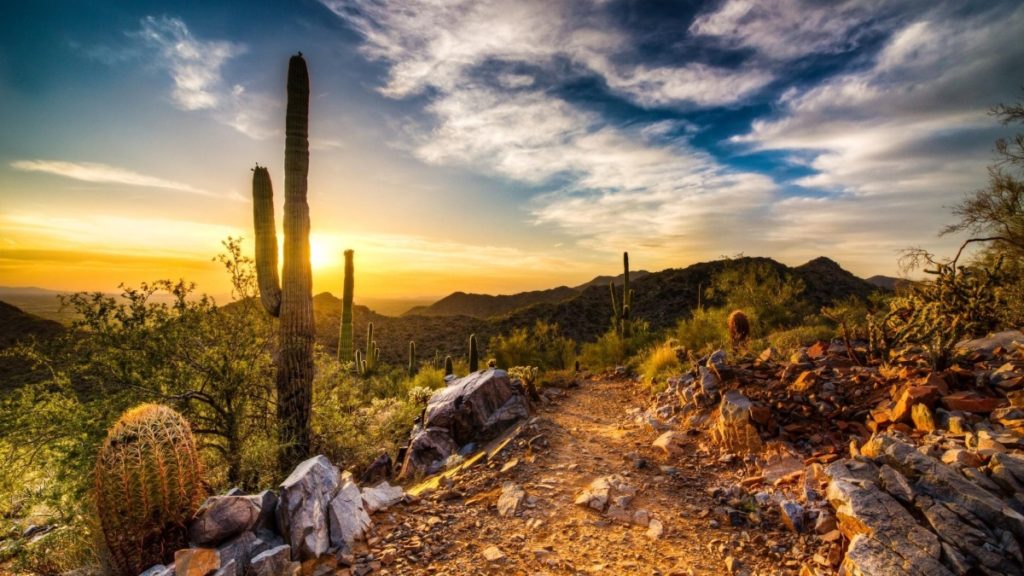
Shrubs of the desert Southwest, United States are found below sea level in the Imperial Valley to where desert meets juniper and oak woodlands at about 5,000 feet above sea level. In this hot landscape , rainfall averages 4 to 8 inches a year, the plants must be tough to survive.
The Chihuahuan and Sonoran deserts make up much of the landscape here. The Sonoran is divided into a colder portion called the Mojave and an almost frost-free portion called the Lower Colorado Desert. Each has its own signature or special shrubs and trees. For example, the Sonoran desert has Saguaro cactus and the Mojave desert has Joshua trees.
The prettiest part of this dry land can be the foothills, where higher elevations mean relatively cooler temperatures. A natural desert garden is made up of small, native trees such as the willow and the Blue palo verde and succulents like cacti and agave. Along with flowering and evergreen shrubs and an assortment of rainy season flowers and grasses., the shrubs of the desert Southwest can withstand hot, dry conditions. Many have extensive root systems. Some are considered evergreen while others shed their foliage if needed to conserve energy.
A diverse variety of plants call the desert home and surprisingly, there is ample birds, butterflies and other wildlife that take advantage of it all. A drip system on a timer or some other water source at dawn and sunsets guaranteed to bring in all the local desert creatures to your Southwestern desert garden. While there are several beautiful and unique shrubs for your Southwest gardens, I am listing a few that are interesting and attract various wildlife.
Red barberry (Berberis haematocarpa)

A large bush with small, dark gray-green leaves that are prickly like holly.
- In early spring, it is filled with small yellow fragrant flowers attractive to pollinators.
- By early summer the shrubs are filled with red fruits.
- Birds, such as White-winged doves, Desert sparrows and Verdins enjoy the sweet fruit. Mammals also enjoy a snack.
- The spiny dense branches provide cover for several small desert critters and birds.
- Red barberry is evergreen and grows to 12 feet high and across. Pruning will keep in smaller if desired.
- Zone hardy from Z-7 to Z-9.
- Requires full sun to a little shade.
- Red barberry is found along the Pinyon pine and juniper belt and needs its fair share of water.
Ocotillo (Fouquiria splendens)
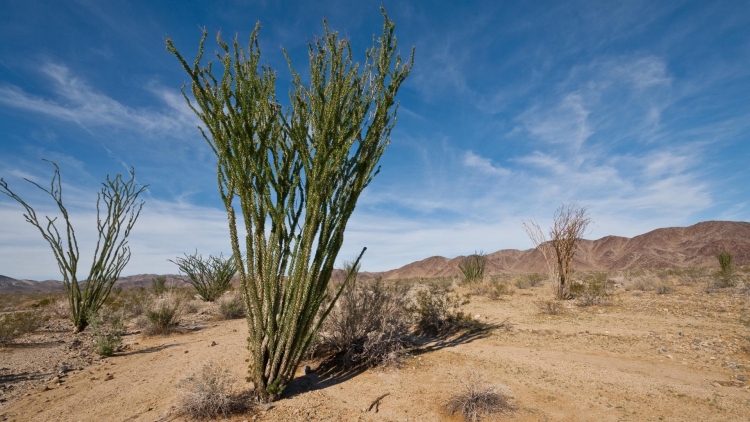
Often Ocotillo shrubs are used as small trees in the landscape. However, instead of a trunk and spreading branches, it has a vase shaped cluster of spiny stems.
- The stems will remain green if you can irrigate from time to time, other wise the foliage will drop and the plant goes dormant in times of drought.
- After warm rains, the end of the stems become bright with large, red to orange flowers.
- The flowers are a source of nectar for hummingbirds, orioles, butterflies and other insects.
- Small birds favor the spiny branches for nest building.
- Zone hardy from Z-8 to Z-10, Ocotillo thrives in full sun.
- Water requirements are low, making this a drought tolerant plant in your desert garden.
Texas Ranger (Leucophyllum frutescens)
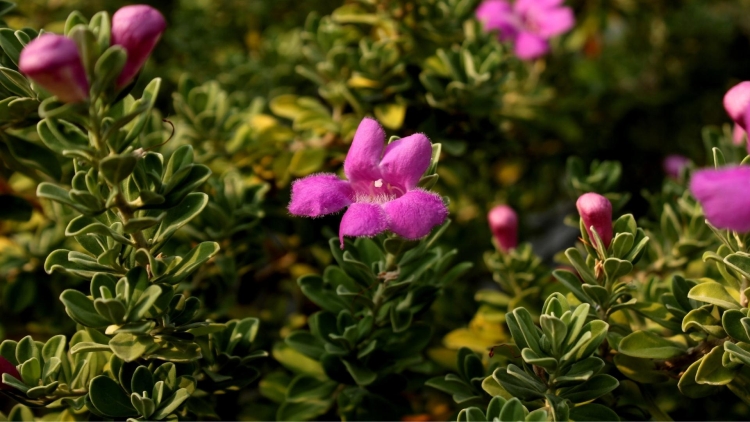
Texas Ranger and other cenizos are all low-growing, Silver-leaved, attractive shrubs. A native of Texas and the Chihuahuan Desert, Texas Ranger blossoms in colors ranging from purple, to pink, to white.
- The flowers appear after a rain in spring, summer and autumn.
- Sometimes the flowers are so numerous that the foliage is almost hidden.
- Zone hardy from Z-8 to Z-10, this evergreen requires full sun. Once established in your desert garden, Texas Ranger has moderate water needs.
- Pruning will keep shrubs small if desired.
- Seeds are a tan color offering food for several birds.
- Several butterflies and bees are attracted by the flowers. Texas Ranger is also a host plant for Theona checkerspot butterfly.
Flame acanthus (Aniscanthus quadrifidus)
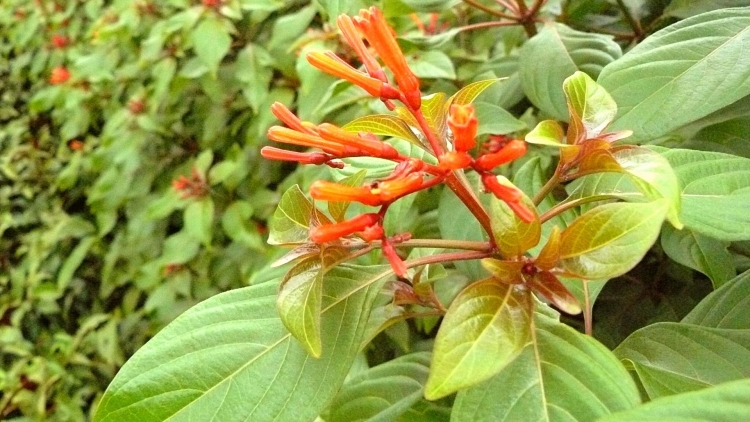
Flame acanthus or hummingbird bush blooms from midsummer through frost. Flame acanthus is covered with long, slender, red or orange blooms that hummingbirds love.
- It is a drought tolerant, heat-loving small shrub that works as well in the perennial border as it does as an informal hedge or specimen plant.
- The bark is light and flaky and makes an interesting winter and early spring accent.
- Flame acanthus is late to come out in the spring, and benefits from periodic pruning or even severe cutting back in early spring.
- It is adaptable to sunny, well-drained exposures throughout the region. A a bush of the desert Southwest, it is a good choice for sites with poor soils and reflected heat.
- Supplemental water in dry summer months will encourage flowering. It is hardy throughout zone 8, and root hardy to zone 7.
- A small shrub that grows to 4 feet and 3 to 4 feet wide.
- It is very heat and drought tolerant, deciduous plant, but added water will encourage blooms.
Chuparosa (Justicia californica)
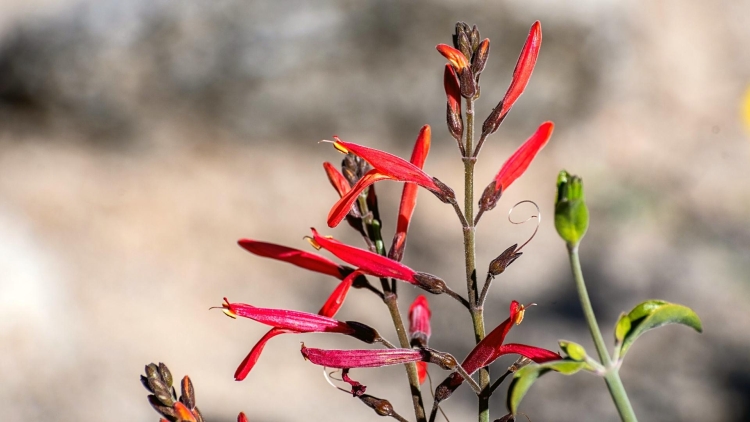
A shrub with evergreen branches for your desert garden. Chuparosa stems or so thick, that the lack of foliage most of the year is hardly noticeable.
- A Sprawling plant that can grow 5 to 8 feet tall and up to 12 feet across if you don’t prune it.
- Leaves will appear for a short time after heavy rains, but the real beauty is the flower power. Small flowers appear in March through May and continue to appear throughout summer and fall.
- These bushes can be trained to climb a trellis or drape a wall.
- Several species of hummingbirds and butterflies will appear with the flowers as well as orioles, warblers. Goldfinches will eat the tiny seeds.
- Chuparosa is also a host plant for the Chara checkerspot butterfly.
- Zone hardy from Z-9 to Z-10.
- Requires full sun to dappled shade.
- Water requirement are moderate.
- For wildlife, Chuparosa is a can’t miss in your Southwest desert garden.
Desert lavender (Hyptis emori)
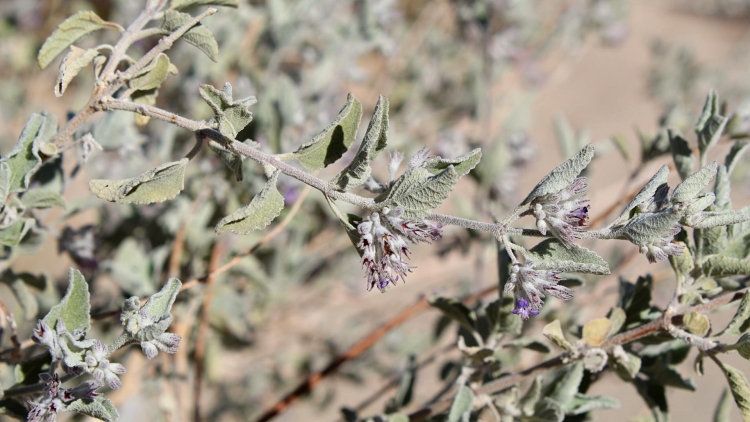
Put some native desert lavender in your Southwest gardens. Desert lavender can be evergreen or a deciduous shrubs, depending if your region is frost free or not.
- Its origins are Northern Arizona, To Southern Nevada and extreme Southeast California up to 3,000 feet in elevation.
- Desert lavender is frost sensitive when young. Thrives in full sun and tolerates reflected heat.
- Evergreen to deciduous plants that can grow 6 to 15 feet tall and 6 to 12 feet wide. Gray bark, powder gray, ovate leaves, up to 2.5 inches long (6.2 cm), 1 inch wide (2.5 cm), with serrated margins.
- The foliage is fragrant, with a heavy sage-like scent, it is used to make herbal tea. The Desert Lavender can be sheared in late winter to maintain shape.
- Zone hardy from Z-9to Z-10 (This plant doesn’t like the cold).
- Little to moderate water once established, drought resistant, needs good drainage, some added water increases growth rate
- The Desert lavender has clusters of violet flowers from spring to fall. The flowers are attractive to bees and butterflies. Small birds find the seeds to their liking.
Summary
I just gave you some basic descriptions on six shrubs of the desert Southwest. They may or may not do well for you. Look around and find other desert plants that work in your region. Littleleaf sumac provides nectar for pollinators. The small fruits offer food for Gamble’s quail other birds and small mammals.
Other shrubs like Littleleaf cordia, offers food for pollinators and food for birds and mammals.
Creosote bush, Red yucca, Apache plume, Cliff rose and other native bushes that provide food and shelter for several birds, butterflies and mammals.
All are drought tolerant and thrive in the desert heat of the Southwest. Desert gardens aren’t just tumbleweeds and sagebrush, but limited only by your imagination.
Enjoy a cold drink and watch your desert gardens grow.
